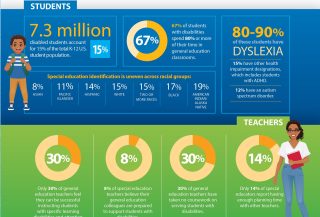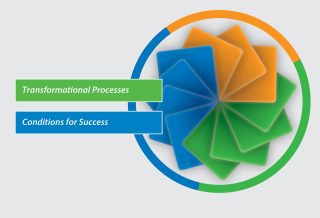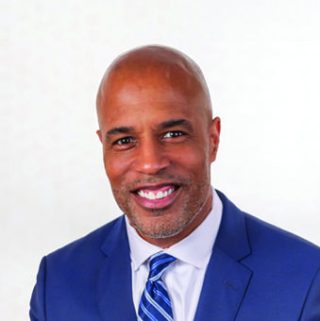FOCUS
The evolution of Standards for Professional Learning
By Stephanie Hirsh
Categories: Standards for Professional LearningJune 2022
Standards for Professional Learning are forward-looking by nature because they drive continuous improvement in educator practice. But taking a brief look at the history of the standards is important for understanding their impact on the field and their role in today’s professional learning.
As the field has shifted philosophy from staff development to professional development to professional learning, and as our organization has grown from the National Staff Development Council to Learning Forward, so, too, have the standards evolved. Over the last 30 years, we have regularly revised the standards to reflect emerging research, new knowledge about best practices, and policy shifts. But we have also retained core elements, continually building on the foundation of the first version of the standards from the 1990s.
I invite you to take a look back as we move forward to see how we have embodied the process of learning and continuous improvement that is so central to high-quality professional learning and educational improvement.
The early days of standards
In the early 1990s, Hayes Mizell, foundation officer for the Edna McConnell Clark Foundation, took an interest in the National Staff Development Council (NSDC). Dennis Sparks, then the executive director of NSDC, has referred to Mizell as the first “angel investor” in the organization because of his commitment to funding our work and lending his field-shaping insights. Both men imagined that staff development would soon play a bigger role in school improvement — and they were right.
To shape that future, Mizell challenged Sparks to codify the characteristics of high-quality educator learning into standards for staff development. This effort initially focused on the middle grades, in keeping with the focus of the Edna McConnell Clark Foundation.
The idea of standards wasn’t necessarily a popular one. For many years, staff development had been driven by teachers’ interests and was presented as a benefit of employment that school systems used to attract new teachers entering the profession. High degrees of participant satisfaction were the sole measure of success.
However, things had begun to change after the release of the widely cited report, A Nation at Risk, in 1983, which alerted the country to challenges in schools. A new focus on improving teaching and raising student achievement gathered momentum into the 1990s, continuing with the passage of the Goals 2000 Act, which required states to develop clear and rigorous standards for student learning as a necessary step in improving student achievement.
For the first time, staff development was seen as having a role to play in improving teaching and learning. Goals 2000 led the U.S. Department of Education to define principles of professional learning, and field leaders like Mizell began calling on educators to make professional learning more intentional and focused on student learning.
NSDC accepted the challenge and, in collaboration with educators from a variety of backgrounds and experiences, created the first set of standards, which were released in 1994. The standards detailed content priorities, such as shifting attention from stress management workshops to adolescent development, as well as learning strategies that emerging evidence were showing to be most effective in improving teaching. The first set of middle grades standards was a success in driving changes in the field, and it led to partnerships with the National Association of Elementary School Principals and the National Association of Secondary School Principals to offer standards for the elementary and secondary grades in 1995.
Revisions to the standards
It was always our intention to update and revise the standards as the field evolved, and we found ourselves creating a pattern of releasing new standards about every 10 years. It took about a decade for our implementation tools and research studies to be fully developed, for the standards to get traction, and for states and other governmental entities to put them through an adoption cycle. And it turned out that 10 years was about the amount of time it took for new knowledge and research to emerge and key education issues to shift, justifying a need for revising the standards.
Toward the end of the 1990s, state and federal governments were paying closer attention to professional development (as it was now known). This interest translated into increasing expectations for educators to demonstrate the impact of professional development investments. As the No Child Left Behind Act of 2001 accelerated the new era of accountability, professional development, like other education initiatives, was asked to document its return on investment.
Simultaneously, NSDC stakeholders were asking for a single set of standards that educators could use to promote the professional development essential to improving their practice. In response, in 2001 NSDC revised the standards into its first full single edition. These standards’ focus on evaluating the impact of educator learning on educator practice and student learning was a direct reflection of policy changes as well as our own recognition of the importance of demonstrating impact.
In 2010, a coalition led by the National Governors Association and the Council of Chief State School Officers released the Common Core State Standards, which articulated in detail what students at each grade level should know and be able to do. Within a matter of months, more than 45 states had endorsed them. Policymakers now looked to professional learning as a way to prepare teachers to support students in meeting the new and more demanding standards.
As professional learning leaders and our organization (which had been recently renamed Learning Forward) responded to that call, three key questions drove planning for the next set of professional learning standards: What are students expected to know and be able to do? What do the adults need to know to support students with their learning? What conditions will ensure adults acquire these essential skills and knowledge?
The 2011 edition of the standards — renamed Standards for Professional Learning — signaled the importance of educators taking an active role in their continuous improvement and placed an emphasis on ongoing learning. The standards focused on educators as part of learning teams and introduced the ideas of data-driven decision-making, long-term implementation, and assessment of impact on student outcomes.
As we neared the beginning of the 2020s, Learning Forward recognized the need to revise the standards once again to reflect research findings from the last decade and address the most imperative issues in education now. Substantive research and the state of our schools had elevated the importance of three key issues that laid the foundation for this revision and the important work that lies ahead: equity, curriculum, and leadership. (More detail about each of these components can be found throughout this issue of The Learning Professional.)
Consistent focus for learning
Despite the shifts over time, the standards have relied on a consistent focus and some enduring qualities. The foundation of the standards has always been an understanding of and expertise in designing and executing adult learning. As the history of education and more specifically professional development shows, effective professional learning depends on more than tips and tools for engaging adults — it depends on effective learning designs, conditions for learning, and content.
The concepts of equity, evidence-based or research-driven practice, system and individual change management, continuous improvement, impact, and content knowledge have always been central, even though some elements could have been more explicit than they were at certain times.
Another key thread throughout the history is that standards have always been a collaborative effort. While the standards always carried the NSDC/Learning Forward name, the intention was never to develop or release them alone. We have always been committed to ensuring there is only one set of professional learning standards shared by the whole field, and this meant ensuring any organization with an interest in professional learning was at the table during the standards’ development and dissemination. The collaboration among many diverse perspectives has been central to the robustness of the standards and their uptake and use.
The use of the word standards has remained consistent — even though it was viewed from the beginning as somewhat controversial. Over the years, there were occasional arguments made for shifting to principles or other related terms, but the word standards offered a unique way of combining the aspirational with the practical.
We have also placed a consistent focus on what educators need to support implementation of the standards. Each edition was followed by tool kits that included needs assessments, planning guides, implementation rubrics, case studies, training materials, and more. Effective execution depends on the understanding and support of school systems and individual educators.
While states could be found adopting, adapting, or endorsing the standards, meaningful and large-scale implementation has always depended on clear leadership and support from multiple entities, including Learning Forward state and provincial affiliates, school systems and schools, and technical assistance organizations.
An essential component
As the standards have evolved over time, and as their use in states, districts, and schools has increased, so has the recognition that professional learning must be viewed as an essential component of the ongoing work of all educators, not as a one-off event or an add-on to an already busy workday. This shift toward meaningful, sustained, job-embedded professional learning is perhaps the standards’ most important contribution to the field.
If teachers are working as hard as they can every day and giving all they have to offer to their students, then the only thing that closes the learning gap is when teachers themselves gain the knowledge, skills, and subject expertise that are essential to helping their students. The only way for teachers to gain this expertise has always been through ongoing effective professional learning. As we move into the next era of revised standards and improved teacher practice, I challenge anyone to find a different answer.
Download pdf here.
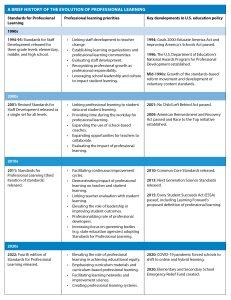
Leading the way to Standards
Standards for Professional Learning have remained relevant and useful for four decades in large part due to the talented individuals who were able to translate their importance to the educators and stakeholders who put them into daily practice. Early editions were overseen by Dennis Sparks and Joellen Killion. This most recent revision was led by a team including Denise Glyn Borders, Tracy Crow, Elizabeth Foster, Paul Fleming, and Machel Mills-Miles. It was no small task for these field leaders to combine the intentions of advisory panel members, guidance from research, and feedback from hundreds of individuals. We are grateful to them for their contributions.
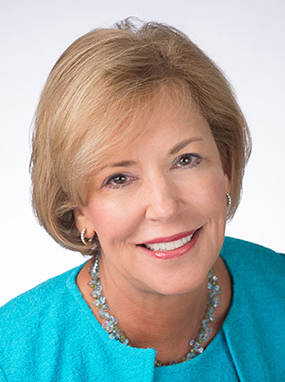
Stephanie Hirsh retired in June 2019 after 31 years with Learning Forward, an international association of more than 13,000 educators committed to increasing student achievement through effective professional learning. Hirsh led the organization as its executive director for the last 13 years where she presented, published, and consulted on Learning Forward’s behalf across North America.
Categories: Standards for Professional Learning
Recent Issues
LEARNING DESIGNS
February 2025
How we learn influences what we learn. This issue shares essential...
BUILDING BRIDGES
December 2024
Students benefit when educators bridge the continuum of professional...
CURRICULUM-BASED PROFESSIONAL LEARNING
October 2024
High-quality curriculum requires skilled educators to put it into...
LEARNING TO PIVOT
August 2024
Sometimes new information and situations call for major change. This issue...



